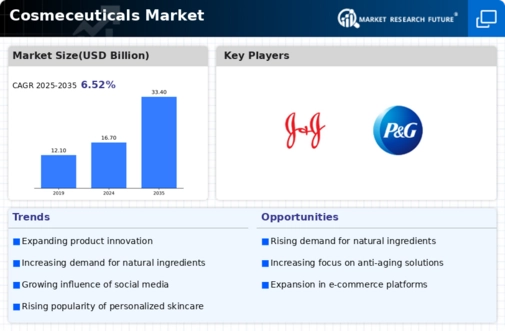Top Industry Leaders in the Cosmeceuticals Market Outlook

In terms of strategies adopted, companies are focusing on product innovation and development to gain a competitive edge. Research and development investments play a pivotal role in bringing forth new and advanced cosmeceutical products. Furthermore, strategic partnerships and collaborations with dermatologists and healthcare professionals are becoming increasingly prevalent to enhance product credibility and consumer trust.
Factors influencing market share analysis encompass product efficacy, brand reputation, distribution networks, and pricing strategies. Companies that consistently deliver effective and scientifically-backed formulations tend to capture a larger market share. Additionally, those with robust distribution networks can easily penetrate diverse markets, ensuring wider product accessibility.
While established players dominate the cosmeceuticals market, new and emerging companies are making significant strides. These entrants often differentiate themselves through niche offerings, innovative formulations, or a focus on specific consumer segments. These companies, though smaller in scale, contribute to the overall market dynamism, challenging established norms and pushing the boundaries of product development.
Industry news highlights the dynamic nature of the cosmeceuticals market, with frequent product launches, collaborations, and acquisitions. Companies regularly introduce novel ingredients, formulations, and delivery systems to cater to evolving consumer preferences and address specific skin concerns. Mergers and acquisitions are common strategies to expand market reach and diversify product portfolios, enhancing overall competitiveness.
Current company investment trends in the cosmeceuticals market indicate a substantial focus on research and development. Companies are allocating significant resources to explore innovative ingredients, advanced formulations, and cutting-edge technologies to stay ahead in this highly competitive landscape. Moreover, strategic marketing initiatives, including digital campaigns and influencer collaborations, are being leveraged to enhance brand visibility and connect with a broader consumer base.
The overall competitive scenario in the cosmeceuticals market remains intense, driven by continuous innovation, strategic collaborations, and aggressive marketing. Market players are navigating evolving consumer preferences, regulatory changes, and technological advancements to maintain and expand their market positions. The landscape is expected to witness further evolution as emerging companies bring forth disruptive innovations and challenge the dominance of established players, creating a market environment that demands adaptability and resilience.
Industry News and Investment Landscape:
- Recent purchases, like L'Oréal's acquisition of CeraVe, demonstrate the market's trend toward consolidation.
- Growing expenditures on R&D indicate an emphasis on future innovation, especially in customized skincare and biocompatible chemicals.
- The market is growing as a result of increased awareness of cosmeceuticals due to online reviews and social media influences.
- specific players face difficulties as a result of regulatory changes in specific areas, such as more stringent approval procedures.
Key Companies in the Cosmeceuticals Market includes –
- L'Oréal S.A. (France)
- Allergan Plc. (Ireland)
- Avon Products Inc. (UK)
- Johnson & Johnson (US)
- Procter & Gamble Co. (US)
- The Estée Lauder Companies Inc. (US)
- Merck & Company Inc. (US)
- Royal DSM NV (Netherlands)
- Unilever NV (Netherlands)
- Evonik Industries AG (Germany)











